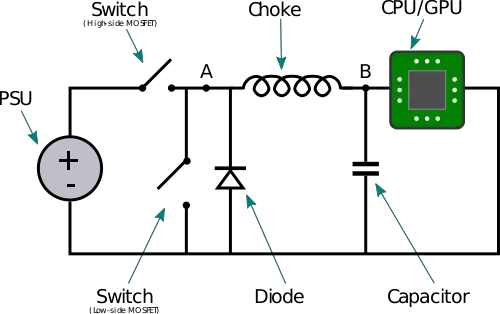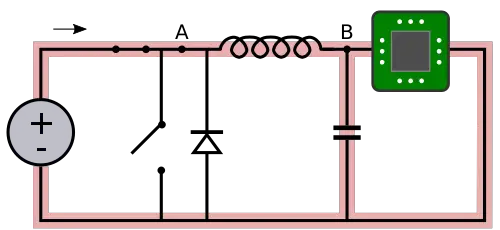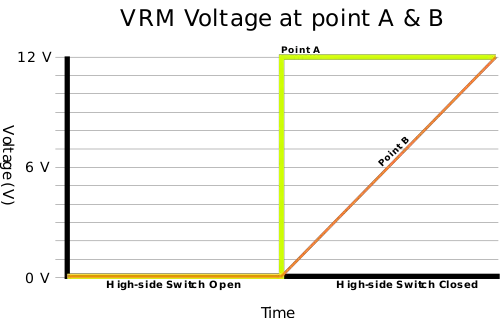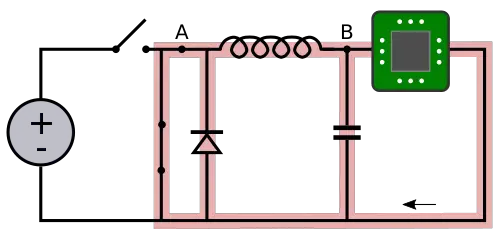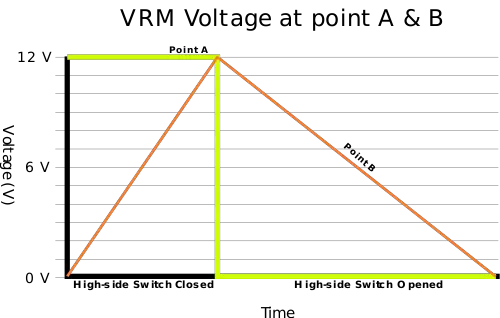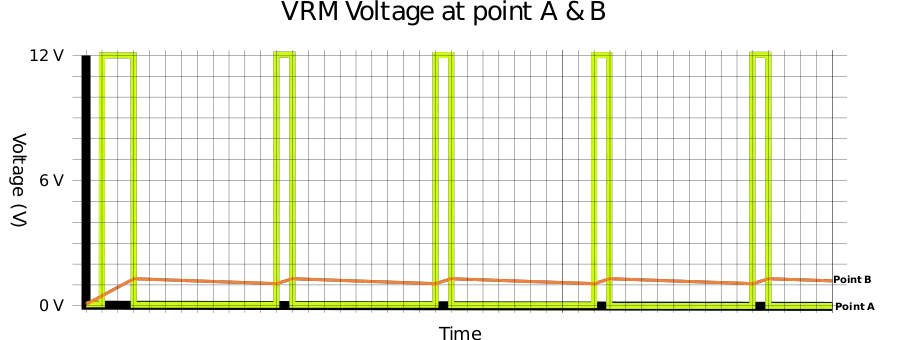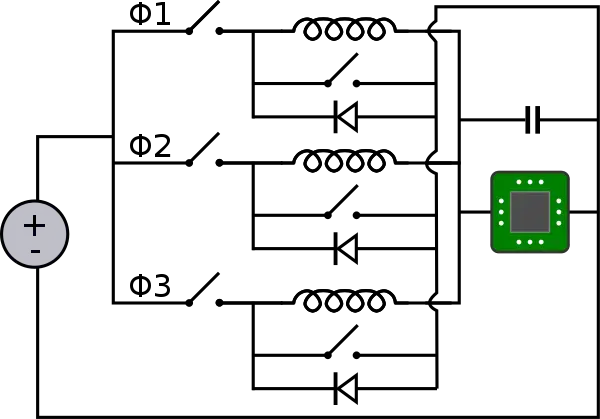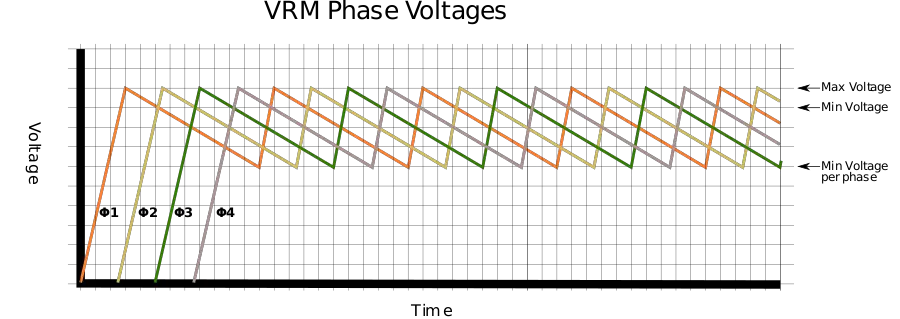Voltage Regulator Module (VRM) or a CPU/V-Core Circuit is an electronic circuit that regulates and down steps voltage from its input (e.g., system power rail) to its output (e.g., integrated circuits). In the context of a typical computer, the VRM converts the 12/5/3.3 V DC power rail that comes from the power supply unit into the much lower operating voltage of the integrated circuit (e.g. 0.8 V, 1 V, 1.2 V). VRMs are typically implemented as a switching regulator such as a buck converter due to their efficiency.
Overview
Single-phase
Generally, a VRM circuit is usually implemented as a buck converter, but this is not strictly the only way to design it. Shown is a basic schematic of a VRM circuit. On the left side is the typical 12 V which comes from the power supply unit. There are two MOSFETs just before point A, a low-side and a high-side, which serve as actual switches. To the left of point B is the choke (or a filtering inductor).
The goal of the circuit is to take the power supply voltage which is 12 V before point A and convert it to the much lower operating voltage of the CPU or GPU at point B which is something like 1.2 V.
Operation
When the high-side switch is closed, the voltage at point A becomes 12 V but the voltage at the other side of the inductor doesn't change instantaneously, instead, the inductor continues to resists change in current. As the 12 V is applied to the inductor, the inductor builds up a magnetic field which creates a voltage drop at the output terminal. As the inductor builds a larger magnetic field (i.e., charges up), the voltage drop becomes smaller and smaller until it's full charged and the voltage reaches 12 V. The graph below depicts the voltage that would be fed to the CPU/GPU at point B if the high-side switch was to remain closed for a sufficient amount of time:
As can be seen, the purpose of the inductor in the circuit is to prevent the voltage from instantaneously reaching 12 V. How quickly the voltage changes will depend on the inductance of the inductor. For example, a small inductor with a low inductance will have a quicker change in voltage since they can build a smaller magnetic field.
When the high-side switch is opened again, the voltage at point A drops back to 0 V. The inductor still has a magnetic field that was built up when we charged it. Since the high-side switch was opened, the inductor's magnetic field starts to collapse, generating current at point B which is fed to the CPU. When this happens, there would is sudden voltage spike at point B. A flyback diode is added to the circuit in order to eliminate this flyback. Since diodes are fairly inefficient, when the circuit opens the high-side switch, it also closes the low-side switch. This is done to allow the current to flow through the switch instead of the diode which acts more like a wire, increasing the efficiency of the circuit. The graph below depicts the voltage that would be fed to the CPU/GPU at point B when the high-side switch is opened and the low-side switch is now closed:
Voltage regulation
The end goal of the circuit is to deliver a constant voltage of our choosing. On a modern microprocessor this might be around 1.2 volts. To achieve 1.2 V, the circuit needs to cut off the inductor charging when the voltage at point B reaches 1.2 V. Once that happens the voltage will start to drop at which point the circuit will go back to charging up the inductor. The entire cycle is repeated forever through a technique known as pulse-width modulation, maintaining the average voltage at the desired operating voltage. At roughly 50% duty cycle, the output voltage at point B will be 6 V. To get our desired 1.2 V the duty cycle should be 10%.
Multi-phase
In a modern computer system, the typical motherboard VRM might have 3 or more phases. A multi-phase VRM works very much like the single-phase VRM described above but uses multiple such circuits in parallel - each phase handling a portion of the total current that the CPU or GPU requires. The trick is that each of the phases are slightly offset such that at any given time, only a singe phase has the high-side switch close and building a charge on its inductor. The rest of the phases are discharging.
By overlapping the phases at an offset, we're still generating the same 1.2 operational voltage, but as one phase starts dropping in voltage, the next phase takes over. This also results in a much stable average voltage that is sent to the CPU because of the tighter voltage tolerance.
It's worth pointing out that since the total amount of current fed to the CPU remains more or less unchanged (when comparing a single-phase VRM to multi-phase), the total current is now distributed among the multiple phases. For example, in a dual-phase VRM, each of the phases will see roughly 50% of the current on average. The effect is that each of the phases now only handle a portion of the total load, putting less strain on any of the individual components.

